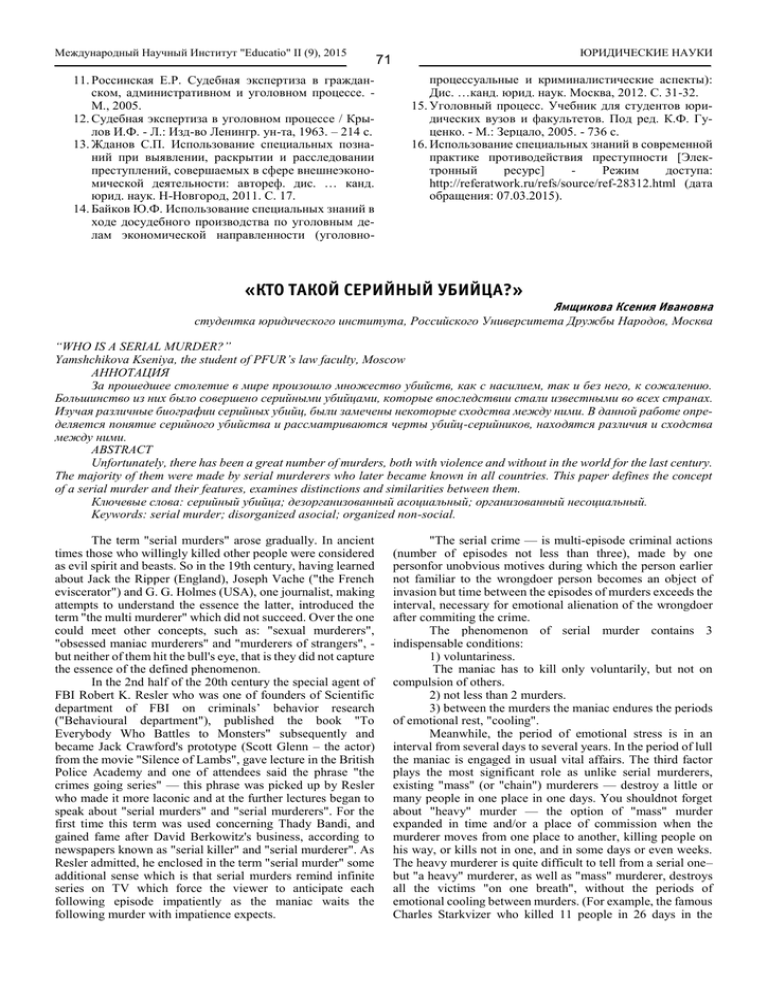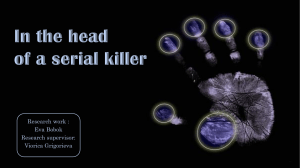Документ 2590394
реклама

Международный Научный Институт "Educatio" II (9), 2015 11. Россинская Е.Р. Судебная экспертиза в гражданском, административном и уголовном процессе. М., 2005. 12. Судебная экспертиза в уголовном процессе / Крылов И.Ф. - Л.: Изд-во Ленингр. ун-та, 1963. – 214 с. 13. Жданов С.П. Использование специальных познаний при выявлении, раскрытии и расследовании преступлений, совершаемых в сфере внешнеэкономической деятельности: автореф. дис. … канд. юрид. наук. Н-Новгород, 2011. С. 17. 14. Байков Ю.Ф. Использование специальных знаний в ходе досудебного производства по уголовным делам экономической направленности (уголовно- ЮРИДИЧЕСКИЕ НАУКИ 71 процессуальные и криминалистические аспекты): Дис. …канд. юрид. наук. Москва, 2012. С. 31-32. 15. Уголовный процесс. Учебник для студентов юридических вузов и факультетов. Под ред. К.Ф. Гуценко. - М.: Зерцало, 2005. - 736 с. 16. Использование специальных знаний в современной практике противодействия преступности [Электронный ресурс] Режим доступа: http://referatwork.ru/refs/source/ref-28312.html (дата обращения: 07.03.2015). «КТО ТАКОЙ СЕРИЙНЫЙ УБИЙЦА?» Ямщикова Ксения Ивановна студентка юридического института, Российского Университета Дружбы Народов, Москва “WHO IS A SERIAL MURDER?” Yamshchikova Kseniya, the student of PFUR’s law faculty, Moscow АННОТАЦИЯ За прошедшее столетие в мире произошло множество убийств, как с насилием, так и без него, к сожалению. Большинство из них было совершено серийными убийцами, которые впоследствии стали известными во всех странах. Изучая различные биографии серийных убийц, были замечены некоторые сходства между ними. В данной работе определяется понятие серийного убийства и рассматриваются черты убийц-серийников, находятся различия и сходства между ними. ABSTRACT Unfortunately, there has been a great number of murders, both with violence and without in the world for the last century. The majority of them were made by serial murderers who later became known in all countries. This paper defines the concept of a serial murder and their features, examines distinctions and similarities between them. Ключевые слова: серийный убийца; дезорганизованный асоциальный; организованный несоциальный. Keywords: serial murder; disorganized asocial; organized non-social. The term "serial murders" arose gradually. In ancient times those who willingly killed other people were considered as evil spirit and beasts. So in the 19th century, having learned about Jack the Ripper (England), Joseph Vache ("the French eviscerator") and G. G. Holmes (USA), one journalist, making attempts to understand the essence the latter, introduced the term "the multi murderer" which did not succeed. Over the one could meet other concepts, such as: "sexual murderers", "obsessed maniac murderers" and "murderers of strangers", but neither of them hit the bull's eye, that is they did not capture the essence of the defined phenomenon. In the 2nd half of the 20th century the special agent of FBI Robert K. Resler who was one of founders of Scientific department of FBI on criminals’ behavior research ("Behavioural department"), published the book "To Everybody Who Battles to Monsters" subsequently and became Jack Crawford's prototype (Scott Glenn – the actor) from the movie "Silence of Lambs", gave lecture in the British Police Academy and one of attendees said the phrase "the crimes going series" — this phrase was picked up by Resler who made it more laconic and at the further lectures began to speak about "serial murders" and "serial murderers". For the first time this term was used concerning Thady Bandi, and gained fame after David Berkowitz's business, according to newspapers known as "serial killer" and "serial murderer". As Resler admitted, he enclosed in the term "serial murder" some additional sense which is that serial murders remind infinite series on TV which force the viewer to anticipate each following episode impatiently as the maniac waits the following murder with impatience expects. "The serial crime — is multi-episode criminal actions (number of episodes not less than three), made by one personfor unobvious motives during which the person earlier not familiar to the wrongdoer person becomes an object of invasion but time between the episodes of murders exceeds the interval, necessary for emotional alienation of the wrongdoer after commiting the crime. The phenomenon of serial murder contains 3 indispensable conditions: 1) voluntariness. The maniac has to kill only voluntarily, but not on compulsion of others. 2) not less than 2 murders. 3) between the murders the maniac endures the periods of emotional rest, "cooling". Meanwhile, the period of emotional stress is in an interval from several days to several years. In the period of lull the maniac is engaged in usual vital affairs. The third factor plays the most significant role as unlike serial murderers, existing "mass" (or "chain") murderers — destroy a little or many people in one place in one days. You shouldnot forget about "heavy" murder — the option of "mass" murder expanded in time and/or a place of commission when the murderer moves from one place to another, killing people on his way, or kills not in one, and in some days or even weeks. The heavy murderer is quite difficult to tell from a serial one– but "a heavy" murderer, as well as "mass" murderer, destroys all the victims "on one breath", without the periods of emotional cooling between murders. (For example, the famous Charles Starkvizer who killed 11 people in 26 days in the Международный Научный Институт "Educatio" II (9), 2015 various cities of the USA and inspired young Stephen King, was such — the "heavy" murderer, but not serial.) It is necessary to emphasize that each of these conditions are mandatory, at non-compliance of even one of them a murderer cannot be considered a maniac. It is also worth paying attention to such an important factor as motive. The scholar V. Obraztsov, an author writing about serial murderers, declares that they can have any motive, even a lucrative impulse. Therefore, the difference between serial murders and other multi-episode murderers is that: o The maniac cannot help killing. o Between the murders a period of emotional rest is mandatory. Serial murderers divide into two types: disorganized asocial and organized non-social. Each of these types has its features. The organized unsocial: The majority of them has highly developed intellect, those with higher education are not rare. Organized criminals are socially competent, they have partners. Some of them make a family. The organized criminal does not feel homesickness. He can work, he has a wide range of acquaintances. Owing to the personal features, it is not difficult for them to make new friends, they are able to make a good impression on people. Such criminals attentively trace info in mass media. The disorganized asocial: In the childhood many of criminals of this type became a victim of physical or mental abuse. Quite often they were 72 ЮРИДИЧЕСКИЕ НАУКИ brought up in incomplete families (without father). If the family was full, the father had low-wage or an unstable job. In the childhood they had few friends, they preferred games and entertainments in loneliness, avoided their peers. The reason of his loneliness is other than the loneliness of an organized non-social criminal. The disorganized asocial criminal is lonely because people around consider him "somewhat eccentric", strange and do not seek for communication with him. For the criminal of this type difficulties in studying and social adaptation are characteristic features. His intelligence is lower than of an average. His status in society is the derivative of components of his personality: unskilled (often the most low-paid) job, deficiency of social contacts (with women in particular). These very features of personality define the very character of a crime: spontaneity, deficiency of elements of the thought-over planning. This type of the criminal feels homesickness and therefore, he often commits crimes "in the neighbourhood", "in a reach zone". As a rule, the criminal of this kind is not interested in the mass media reports. The laxity, characteristic for him, being disorganized, untidy can be found on a scene of crime until he is caught. Robert K. Resler made a huge contribution to criminal investigation technique, defined the concept of "serial crime". He also divided all serial murderers into 2 types, differing among themselves. Таблица 1 Differences between 2 types of serial murderers Organized non-social Disorganized asocial Crimeisplanned Crime is spontaneous The victim is purposefully chosen from among strangers The victim is unknown The victim is personalized The victim is depersonilized Excanges are under control Exchanges are of minimum Crime scene is under control Crimesceneischaotic The pray is humble Sudden violence The pray is tied The pray is not tied Aggressive movements Murder weapon is prepared in advance Improvised means are used for murder Список литературы 1. Образцов В.А., Богомолова С.Н. Криминалистическая психология: монография. М.: Юнити-Дана, Закон и право, 2002. – 448 с. 2. John Douglas, Ann W. Burgess, Allen G. Burgess, Robert K. Ressler Crime Classification Manual: A Standard System for Investigating and Classifying Violent Crimes: Jossey – Bass, 2006. – 572 с.





